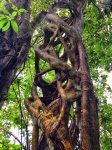

Sawgrass has a point.
You know those awesome deadwood junipers that dominated the Artisan's Cup?
Doesn't happen around here. They're totally "unnatural. Lol! Why on earth would anyone say they're "natural"?
Ficus, too. They'll die "out in nature" here every winter.
Do I sense your sarcasm?
Regardless, the problem I see is that every time one says something cannot happen in nature, we find out that it can in one form or another they can. Yes, perhaps Azealas cannot have a spiraling root mass, but does it matter? We use junipers to simulate pines when they rarely grow as such. The Japanese have been styling pines in a way for years that don't look like pines. We style maples, ficus and a whole list of other trees to look like sumos and they don't grow as such, we style weeping trees to look like willows, which don't grow as such, and we cascade trees that rarely if ever cascade. And the list goes on and on... pines shaped with s curves are ok, but ficus are not?
Some times I just think we should appreciate it for what it is and stop always questioning.
As far as the OP'S tree... roots don't have to have a radiating perfect nebari. Few trees in life actually have this as well. So, this is not natural either... but, I think the key is to have roots that look cohesive, what ever they are. The two pictures of my trees posted have roots exposed. They are both trees that naturally have this occurring in nature. Yet, I have had so many folks tell me they are not correct because they don't feel that they happen in nature?
So, for me then it really dwells into not what actually happens in nature, but what the notions are of what the viewer thinks is a good design to a tree. With the OP'S tree, I think we're the problem lies is that if all of the roots were similar and all over b the place... one might be able to say ok, this works because they are all this way and they support a similar story. They are cohesive. But, they are not this way... their are a few that are above ground going every direction, and at the very base, one's radiating... I think it would be better, if one or the other.





















